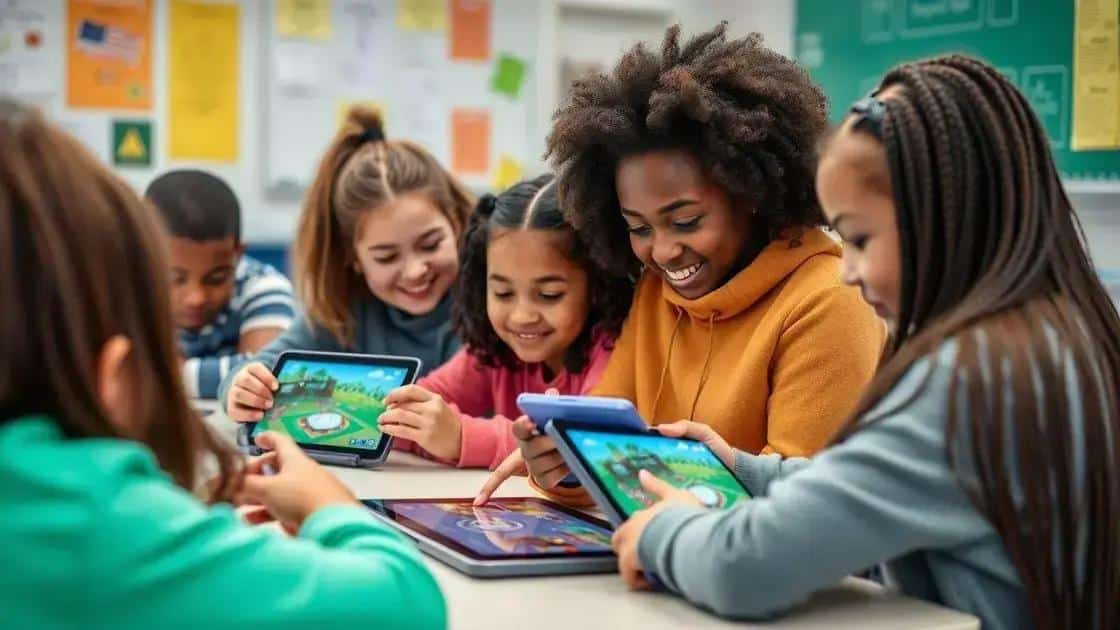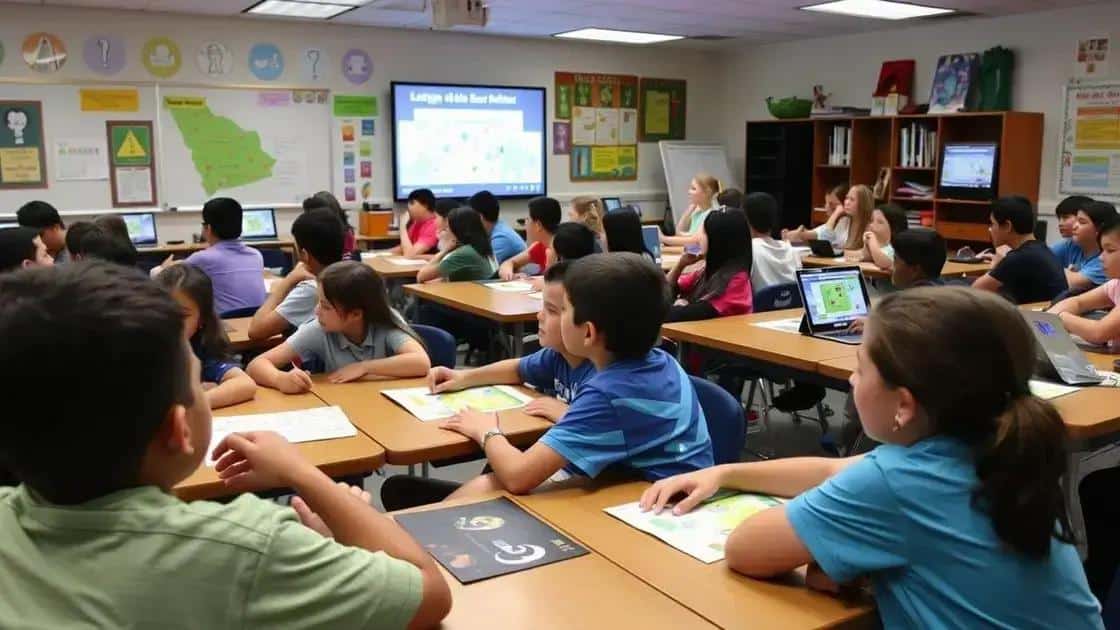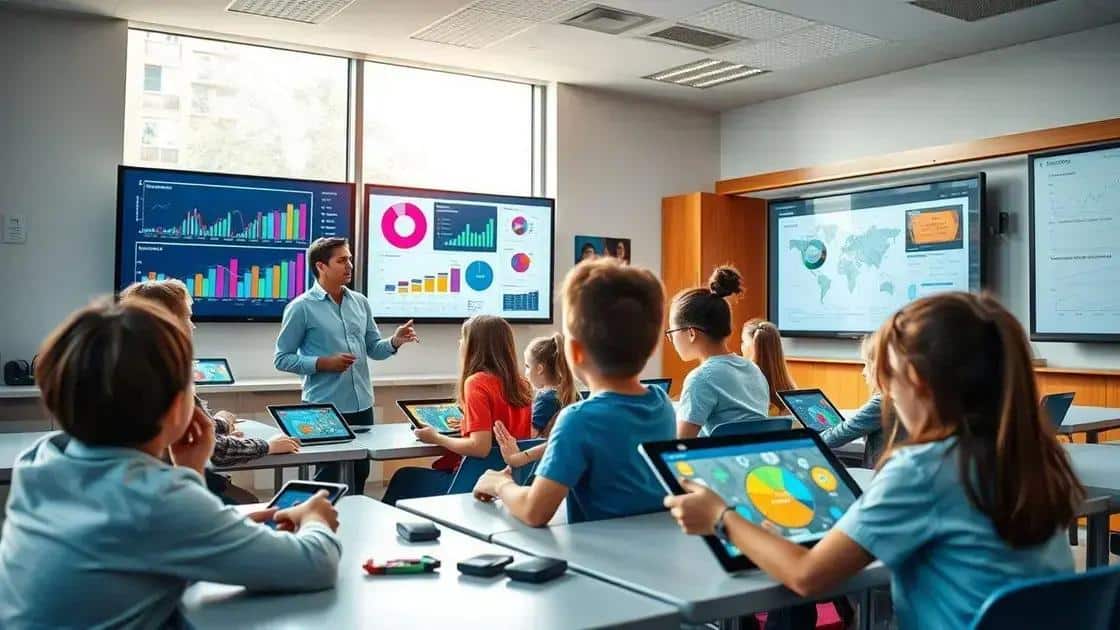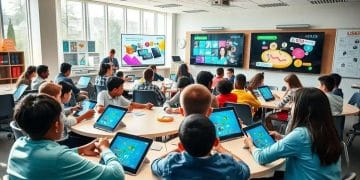Insights on gamified learning platforms that engage students

Gamified learning enhances student engagement and motivation by incorporating game elements, providing immediate feedback, and allowing personalized learning, ultimately leading to improved educational outcomes.
Insights on gamified learning platforms are reshaping education by making learning fun and interactive. Have you ever wondered how these platforms can enhance student engagement? Let’s delve into their potential.
Understanding gamified learning platforms
Understanding gamified learning platforms is essential in today’s educational landscape. These platforms use game-like elements to motivate students and enhance learning experiences. They make learning interesting and interactive, drawing students into topics through fun activities.
Key Components of Gamified Learning
Several key components define gamified learning platforms. These elements work together to create an engaging environment:
- Points and Rewards: Earning points for completing tasks can motivate learners.
- Levels and Challenges: Students advance through levels, making learning progressive and engaging.
- Immediate Feedback: Instant feedback helps learners understand concepts and make improvements.
Integrating these components can lead to increased student engagement. When kids see progress, they are more likely to stay committed to their studies. Additionally, using gamification in learning can cultivate a sense of competition. This can encourage students to achieve more while having fun.
Why Gamification Works
Gamification taps into the natural human desire for achievement and recognition. By introducing game design elements, education becomes more appealing. Furthermore, it can cater to different learning styles, accommodating visual and kinesthetic learners effectively.
Gamified learning platforms often use storytelling to make the experience more relatable and encouraging. The narrative draws students into learning and keeps them engaged with the subject matter. Overall, the ability to incorporate fun and creativity transforms traditional learning experiences into something dynamic and effective.
As educators leverage these platforms, they open doors for innovative teaching methods. Understanding how gamified learning works allows educators to harness its potential effectively and foster an environment where students thrive.
Key benefits of gamified learning in education

When it comes to education, the key benefits of gamified learning are profound. This approach enhances students’ motivation and engagement, making lessons more interactive and enjoyable. Learning becomes a game, which not only excites students but also improves educational outcomes.
Improved Engagement
One of the most significant benefits is the improvement in student engagement. Gamified learning makes lessons feel less like chores and more like challenges. Teachers find that students are more likely to participate actively when they can earn rewards or achieve levels. This is crucial, as high engagement often leads to better understanding and retention of material.
- Increased Motivation: Gamification taps into students’ intrinsic motivations, encouraging them to complete tasks and learn new concepts.
- Enhanced Learning Experience: Games often provide a rich sensory experience, making complex subjects easier to grasp.
- Fostering Competition: Healthy competition among peers can drive students to achieve greater success in their studies.
Another benefit lies in the immediate feedback that these platforms provide. Giving students prompt rewards and constructive criticism supports their learning process. When learners know how they are doing in real time, it can motivate them to continue working hard and improve.
Personalized Learning Paths
Furthermore, gamified platforms allow for personalized learning paths. Each student can move at their own pace, mastering topics before moving on. This ensures that learners fully understand concepts before progressing, which is essential for building a solid educational foundation.
Additionally, gamified learning accommodates various learning styles. Whether a student is a visual learner or one who thrives in hands-on environments, gamified platforms can cater to these differences effectively. This adaptability can lead to better outcomes for all students, regardless of their learning preferences.
Incorporating tangible rewards such as certificates or small prizes enhances students’ sense of achievement. Every goal they reach reinforces the idea that hard work leads to success, fostering a positive attitude toward learning. Overall, the key benefits of gamified learning in education create a fun, supportive atmosphere conducive to both academic and personal growth.
Strategies for implementing gamification
When looking at strategies for implementing gamification in education, it is essential to consider various techniques that can enhance the learning experience. Gamification can transform ordinary lessons into exciting adventures, making learning more interactive and enjoyable. Below are some effective strategies that educators can use to incorporate gamification into their classrooms.
Start with Clear Learning Objectives
Before introducing any gamified elements, it is crucial to define clear learning objectives. Educators should outline what they want students to achieve through gamification. These objectives will help shape the game mechanics and ensure that the interactive elements support educational outcomes. When students understand the goals, they are more likely to stay focused.
Incorporate Game Mechanics
Using various game mechanics can significantly enhance the learning environment. Consider implementing:
- Points System: Reward students with points for completing tasks, participating in discussions, or helping classmates.
- Badges: Offer badges as recognition for achievements, motivating students to reach new milestones.
- Leaderboards: Create leaderboards to foster friendly competition, encouraging students to strive for high rankings.
These mechanics help create a sense of accomplishment and urgency in students. As they progress and earn rewards, they become more engaged and motivated to learn.
Use Storytelling to Create Context
Integrating storytelling can make gamification more effective. By crafting a narrative that aligns with the learning content, educators can draw students into the material. Consider creating a theme for lessons—such as a quest, adventure, or mystery—that adds excitement to the educational experience. When students feel like they are part of a story, they often become more invested in learning.
Another effective strategy is to involve students in the creation process. Encourage them to contribute ideas for the game mechanics or story elements. This inclusion fosters a sense of ownership and encourages higher engagement levels. As students feel their contributions matter, they are more likely to participate fully in the learning experience.
Finally, assess and adapt the strategies used in gamification. It is essential to gather feedback from students on what works and what doesn’t. By being open to adjusting the approach, educators can continuously improve the gamified learning experience and better meet the needs of their students.
Measuring success in gamified learning

Measuring success in gamified learning is essential to understanding its effectiveness. To harness the full potential of gamification, educators need to assess how well these strategies are working in engaging students and enhancing their educational outcomes. Several methods can be applied to gauge success.
Define Success Metrics
First, it is important to define clear success metrics. This means outlining specific goals that the gamified elements aim to achieve. Metrics may include:
- Student Engagement: Track participation levels in activities and discussions.
- Knowledge Retention: Conduct assessments to measure what students remember after gamified lessons.
- Completion Rates: Monitor how many students finish tasks or levels.
By focusing on these areas, educators can collect relevant data that reflects the impact of gamification on learning.
Gathering Feedback
Another key method for measuring success is gathering feedback from students. Students can provide insights into their experiences with gamified learning. Surveys and informal discussions can help teachers understand what students enjoy or struggle with. This feedback allows for adjustments that can improve the gamified environment.
Observing student behavior in the classroom can also complement these methods. Teachers should pay attention to how actively students participate when gamification elements are in place. Are they more focused? Do they demonstrate excitement during lessons? These observations provide qualitative data that is just as valuable as quantitative measures.
Analyze Performance Data
In addition to surveys, analyzing performance data can reveal trends in student achievement. Comparing grades or test scores before and after implementing gamification can provide insight into its effectiveness. It may also be useful to segment data by the demographics of students to see if certain groups respond better to gamified strategies.
Overall, measuring success in gamified learning requires a multi-faceted approach. By combining quantitative data with qualitative feedback, educators gain a comprehensive understanding of how these strategies influence student learning. This knowledge empowers teachers to refine their techniques and maximize the benefits of gamified learning.
FAQ – Frequently Asked Questions about Gamified Learning
What is gamified learning?
Gamified learning is an educational approach that integrates game elements and principles to enhance engagement and motivation in students.
How does gamification improve student engagement?
By making learning enjoyable and interactive, gamification encourages students to participate more actively, thus increasing their engagement.
What are some strategies for implementing gamification in the classroom?
Effective strategies include defining clear learning objectives, incorporating game mechanics, using storytelling, and gathering student feedback.
How can I measure the success of gamified learning?
Success can be measured by tracking student engagement, knowledge retention, completion rates, and gathering feedback from students.





